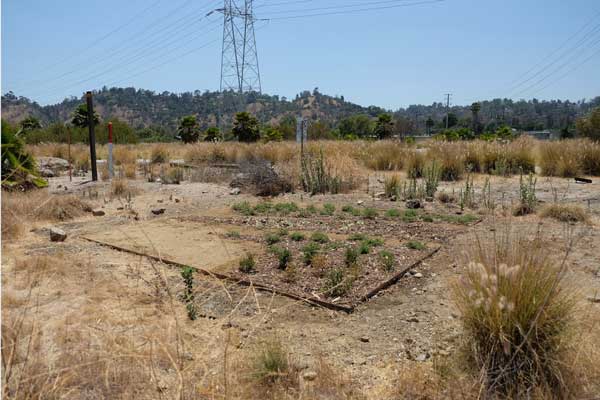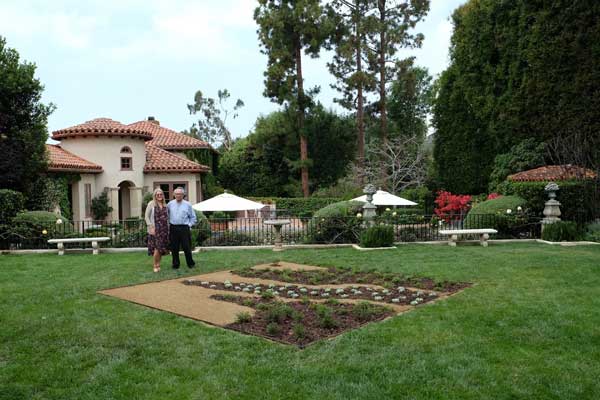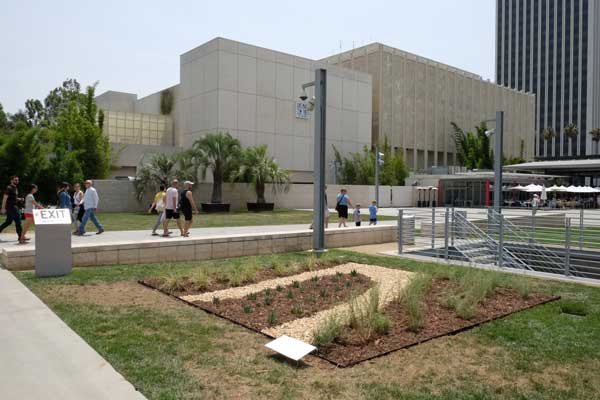Mel Chin’s latest public art project in Los Angeles, The Tie that Binds: MIRROR of the FUTURE, was initiated last summer during CURRENT: LA Water, the city’s inaugural month-long Public Art Biennial presenting temporary large-scale artworks sited along the LA River and in other water-adjacent locations. The biennial came and went via a whirlwind of press events during one of the hottest summers ever recorded in LA. However, Chin’s definitions of temporary, large-scale, and public are concepts that the artist decidedly, and thankfully, challenged, negated, or outright ignored.
Chin is no stranger to breaking boundaries, mixing things up, or waving a flag where no one is looking. With almost 30 years of performing ecologically engaged art in unlikely places, he’s a maverick whom art-world know-it-alls often don’t know. His early soil remediation demonstration project Revival Field, of 1991, explored methods for removing heavy metals from Pig’s Eye Landfill in Minnesota, an art/science collaboration (almost not) funded by the NEA. In 2006 his Operation Pay Dirt project commenced after Hurricane Katrina; it is an ongoing community-based lead-poisoning-education program based out of New Orleans. Discussing his soil work in a video interview with ecoartspace in 2015, Chin stated, “It’s not about chasing down dirty spots, or badness. It’s about approaching the world and being compelled into action.” He added, “I was trying to push forward a new aesthetic that was forming—the aesthetics of our existence.”

Mel Chin, The Tie That Binds (Double Bowtie and South L.A.), 2016.
After scouting sites in LA in fall 2015 and making his proposal in February, 2016, Chin received a green light from Bloomberg Philanthropies in March. This left him with three months to install his work before it was presented to the public in July. With such a short time line, and with only one month of public engagement, in all practicality, this might seem impossible. But the real question is: Why would Chin, or any of the artists involved, want to make temporary art with hundreds of thousands of dollars, while addressing water issues in a region that has been suffering a severe drought for six years and counting. Wouldn’t something more permanent or “practical” be more effective?
Chin’s visionary though not-so-easy-to-achieve solution was to create a collective citywide drought-tolerant landscape. To realize this goal, he created eight demonstration gardens, which he sited along the LA River at the Clockshop Bowtie Project, near the intersection of the 2 and the 5 freeways. Using a postwar real-estate developers’ tract “model home” format, he pitched the gardens to potential “customers”—in this case, biennial-goers, to select a “floor plan,” or garden, which they were invited to create for themselves in their own backyard or community space. Willing participants were given a blueprint and an installation manual to execute the gardens. Chin also created “mirror gardens,” replicas of the same gardens at the Bowtie, alternatively sited primarily in the yards of private homes in Brentwood, South LA, Porter Ranch, Sun Valley, and Boyle Heights, as well as public spaces at Occidental College and the Los Angeles County Museum of Art.
All garden plots are 15-feet-square and are framed like a piece of art with a steel metal border and a standard high-quality edging, mostly recycled/reused and donated by California State Parks. Inside are curvilinear rows of drought-resistant chaparral plants—sages, native grasses, and succulents donated by Village Nurseries. Chin consulted with architects Calvin Abe and Glen Dake on landscape design and plant palettes, and with the Theodore Payne Foundation on plants. The drawings for the blueprints were then created by the artist.

Mel Chin, The Tie That Binds (Brentwood and Double Bowtie), 2016.

Mel Chin, The Tie That Binds (Brentwood and Double Bowtie), 2016.
Chin’s The Tie that Binds: MIRROR of the FUTURE was conceived as an emergent and integrative ecological action for LA. The project includes an edition of 512 blueprints for unique gardens, of which 116 blueprints have been distributed to date. Bloomberg funding covered the creation of the eight Bowtie Gardens and the “twin gardens,” as well as the printing of the blueprints. Although there has been no funding yet on the additional 396 unclaimed blueprints or the creation of the 116 gardens from blueprints already claimed, Chin sees this as a long-term project, a common strategy of his. He even created fellowship opportunities with students at Cal Poly Pomona and Otis Art Institute for what he has named the Follow Through Crew. Their role in the coming months will be to support blueprint holders in planting their gardens by offering consulting, home site visits, and documentation. A video is also in development to provide resources for plants and garden adaptations for different soils and shade/sun conditions. In 2017, Chin will continue to identify participants to create his drought-tolerant gardens, with the goal of saving millions of gallons of water annually for Los Angeles. However, as with all of his ecological projects, he states, “There’s a point where you start it, and a point where you must leave it.”
Most of the artists in the biennial created a one-time sculpture or event. While Chin’s approach could be seen as more garden design than art, his blueprints do operate as a kind of artwork or ephemera. Considering the project from a landscape perspective, xeriscape gardening as art is probably more in the realm of environmental education. Although, with Chin’s Tie That Binds, most importantly, he is provoking the public to engage in a collective action, an artwork addressing water issues in their own backyard. This call to action, combining aesthetics and nature in a way that mimics our interdependence, is a “watershed” strategy for ecological art. It is Chin’s modus operandi to make art that contributes to the greater good while, at the same time, questioning the role of the artist and the art. And all the while, he manages to push the boundaries of the very institutions that fund his projects—in this case, using public funds to create art mostly in private spaces.
The Tie That Binds comes during the backlash of “grass wars” gone bad in Los Angeles after the Metropolitan Water District of Southern California rolled out its Removing Lawns Rebate program in 2014. Over a two-year period, the program allocated a large part of the monies to a private company, Turf Terminators, which absorbed millions of dollars and created heat islands by installing gravelscapes, with few drought-resistant plantings. In the end, the program removed almost three thousand football fields of grass, saving 7.5 billion gallons of water, enough to fill 280 Olympic-size swimming pools per year. Yes, the program saved water, although it desiccated the landscape by reducing water retention in the LA Basin. At least with Chin’s vision, we can help mitigate some of these short-term “solutions,” which make for bad landscapes, as well as create a model for public art that can have long-term effects. “The biggest threat to soil is people. Human beings. The track record is terrible,” states Chin. “If we can do one thing, if we can contribute one thing, to be a cog or something in that transformative process, that’s how I see my place in it.”


